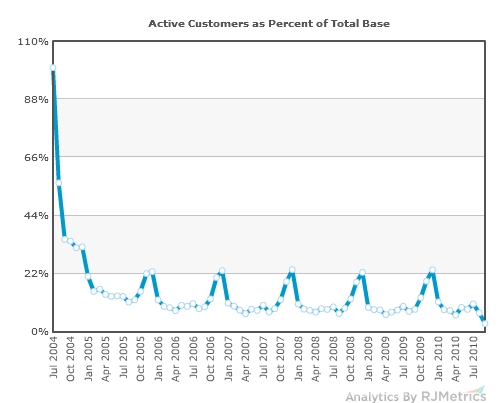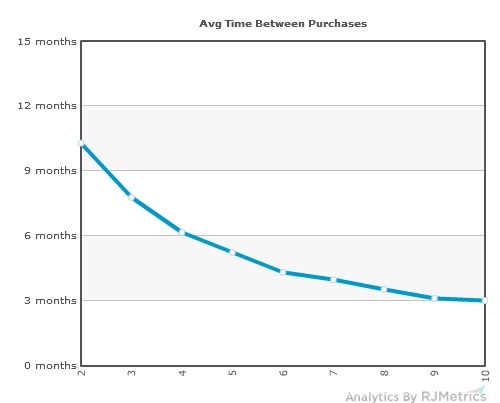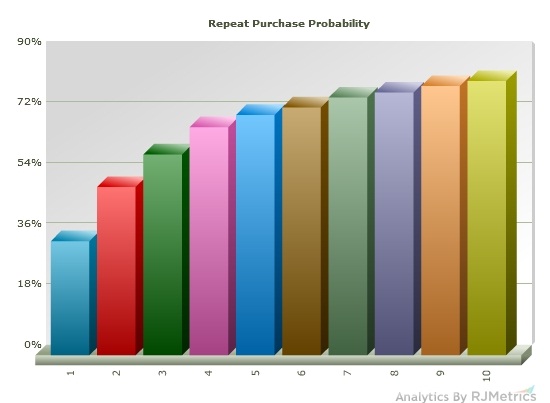At RJMetrics, I’m lucky to work with smart people at successful companies to help them analyze mountains of complex data. What I find remarkable is how many of the same metrics are consistently relevant to companies across all sizes and industries.
Today, I will explore six such metrics that are related to customer retention and loyalty. If you’re not already tracking these metrics for your business, I suggest you start. Metrics like these should be closely watched and can help inform major decisions around marketing, customer retention, product development, and more.
Preparation: Define Users and Actions
Before we start, answer these two questions: who are your users and which of their actions matter?
The first part should be easy. Your purchasers, members, subscribers, or visitors are your company’s lifeblood. Depending on your industry, the second part could be a bit subtler. In e-commerce, the obvious “action” is a purchase. In social media, that action might be a login or user interaction. For publishers, it may be a visit or page view. As a rule of thumb, this action should be an undeniable indicator of value; users who do it more should be more valuable to your company.
With these two definitions in place, we are ready to do some analysis.
Metric One: Engaged Users
Usually, getting more users means increasing the value of your business. However, simply looking at “total users since the dawn of time” is never enough. Quality outweighs quantity when it comes to building long-term value.
As we saw in our analysis of Twitter’s Data, “total users” can be a tremendous overstatement of another metric that actually means much more: “engaged users.” This metric examines the number of distinct users who have committed an action in any given time period. This is your real customer base, and it’s directly tied to the value of your business. Appropriately, it’s also the population that savvy investors and acquirers will consider when determining a valuation.
It is also worthwhile to examine how this number has changed over time and in proportion to your total user base. What percent of your total user base (any user who has ever committed an action) came back to act again last month? Yesterday? How has that proportion changed over time? The direction of that chart can indicate how the quality of your average customer is evolving.
This chart shows active customers as a percent of the total customer base. The trend starts at 100% in the company’s first month, then rapidly stabilizes (with some seasonality)
Metric Two: Repeat vs. First-Time Actions
To build on our study of engaged users, we need to distinguish between user acquisition and user retention.
Imagine a social network in which users sign up, commit one action, and then never return. If this network was able to double the number of new signups it received each month, its “engaged users” chart would actually look quite impressive. However, a quick look at a chart of “first time actions” vs. “repeat actions” would allow us to quickly see through the façade.
If each action generates value for your company, this metric allows us to view the relative value creation from new and existing users. If this ratio is biased toward new users, you might soon hit a wall. If it’s biased toward existing customers, you may have already hit one.
Metric Three: Time Between Actions
Once we’ve identified a universe of “repeat users,” we can gain more insights into their behavior by studying how much time passes between the average user’s actions.
An e-commerce site might see an average value of 75 days. A gaming company might see an average value of 15 minutes. It can be valuable to see how this value changes over the life of your business and over the life of a given customer.
For example, looking at the “average time between first and second action” for users registered in each month of your company’s life helps you determine if you’re getting better at retaining new users. Similarly, comparing the “average time between first and second action” to the “average time between second and third action” (and so forth) can help you determine when and how to remarket to existing users.
Here, the “next purchase number” is shown on the x-axis. For many businesses, the average time between purchases drops with each subsequent purchase.
As with all of these metrics, examine how these numbers differ by customer segments (based on anything from demographic information to behavioral tendencies to acquisition channel). The results might cause you to act differently when working to attract and retain customers.
Metric Four: Repeat Action Probability
This metric is a study of the “action funnel.” For each user who acted once, how many acted a second time? A third?
I like to look at this in two ways. The first is as a count of actions by action number, illustrating the steepness of the funnel. The second is as a “probability” based on historical data, illustrating how each action impacts the likelihood of the next. (Of course, you should beware of interpreting this as an actual probability if you don’t have a lot of historical data.)
Here, “purchase number” is shown on the x-axis. For many businesses, each incremental action makes a subsequent action more likely.
Many of our customers are surprised when they see their data displayed this way. A steep drop-off from action-to-action is quite common, as is a very large increase in the repeat probability from action to action. The take-home message: loyalty snowballs quickly, but most users never start rolling at all.
Metric Five: Customer Lifetime Value
You’ve probably heard this term before, and rightfully so. Customer lifetime value is specific to each customer and it allows you to identify just how valuable different customer segments really are.
If your “action” is something binary like a login, the value this metric tracks may be a count of those actions. However, if it’s an action tied directly to a value like revenue or gross margin, such as a purchase, it is likely the sum of those action’s values.
To many, customer lifetime value is more than the amount of value generated by a customer so far. It can be expanded to include a projection of subsequent value a customer is projected to generate. Conducting this calculation can be complex, however—I’ll leave that for another post. For now, you can use “value generated so far” as a good proxy when comparing users with similar first action dates.
To examine this metric, calculate it for every customer and then segment those customers as you see fit. This can be a great jumping-off point for identifying customer segments who are performing well (so you can acquire more like them) and those who are underperforming (so you can find out why and reverse the trend).
Metric Six: Cohort Analysis
If I was stuck on a desert island and could only take one chart, it would be a cohort analysis.
The cohort analysis groups users into “cohorts” based on the time period in which they committed their first action (and/or other available attributes). Then, it charts the value of each cohort’s actions in each subsequent month of their lifetime as users.
Several cohorts are typically shown on the same chart, allowing for a layered view of how these cohorts perform in general as well as relative to one another over the lifetime of your business.
Since most businesses see a dropoff in actions after the first period and there may be huge variation in the number or value of actions from cohort to cohort, the most consumable form of a cohort analysis chart shows each data point as a percent of the first period’s value. These charts typically exclude the first month, since by definition that value is always 100% for each cohort.
A Cohort Analysis can incorporate elements of all the other metrics discussed in this post.
For a more detailed explanation, check out our Cohort Analysis website. I include it here today because it’s the one chart that incorporates the valuable information explored in each of the other five metrics.
Conclusion
These six metrics are at the core of some of the most powerful analyses conducted by the world’s largest and most successful businesses. Advances in technology have made them accessible to companies of all sizes, and products like RJMetrics allow businesses to monitor them with minimal effort.
While business models differ, a core objective is often the same: creating value. Tracking these metrics can empower any company to better understand their customers, generate greater value, and increase their chances of success.





Pingback: Six Metrics Every Business Should Track – J Stein | Startups Knowledge Base